Electrochemical catalytic oxidationof p-aminophenol at p-phenol modifiedgraphite paste electrode by cyclicvoltammetry and PM6 semi-empiricalmolecular orbital theory
2016-08-07ZHUYongchunJIANGQingxiaoSUGuitianCHENQingyang
ZHU Yongchun, JIANG Qingxiao, SU Guitian, CHEN Qingyang
(1.Institute of Catalysis for Energy and Environment, Shenyang Normal University, Shenyang 110034, China;2. College of Chemistry and Chemical Engineering, Shenyang Normal University, Shenyang 110034, China)
Electrochemical catalytic oxidationof p-aminophenol at p-phenol modifiedgraphite paste electrode by cyclicvoltammetry and PM6 semi-empiricalmolecular orbital theory
ZHU Yongchun1,2, JIANG Qingxiao2, SU Guitian2, CHEN Qingyang2
(1.Institute of Catalysis for Energy and Environment, Shenyang Normal University, Shenyang 110034, China;2. College of Chemistry and Chemical Engineering, Shenyang Normal University, Shenyang 110034, China)
The graphite powder surface is chemically modified by p-aminophenol with a diazo-reaction, and used to compose a carbon paste electrode. At the modified electrode, p-aminophenol shows an electrochemical catalytic oxidation with an oxidation potential negatively shifted for about 73 mV and an increase of the oxidation peak current for about 60% compared with that at a carbon paste electrode without the modification. In order to deeply understand the catalytic oxidation from molecular view, PM6 of a semi-empirical quantum chemical method in MOPAC2012 software was used in the study of electrochemical catalytic activity of the system based on the molecular cluster models of a piece of graphene with 38 carbon atoms as the surface of graphite powder, p-aminophenol and its diazo-reaction product in vacuum conditions. The calculation results show that all the molecular cluster models are thermodynamic stable with negative Gibbs free energies of the reactions. The analysis of frontier orbital gives out an electron transfer induced electrochemical catalysis. The electrochemical redox mechanism of p-aminophenol at modified and unmodified carbon paste electrodes were qualitatively explained. The exchangeable electron of p-aminophenol at p-aminophenol modified carbon paste electrode is about 64.8% larger than that at unmodified carbon paste electrode, which is accord well with the increase of oxidation peak current, and the anodic and cathodic potentials have a linear relation with the energies of HOMO and the LUMO of the molecular clusters of p-aminophenol.
semi-empirical molecular orbital theory; p-aminophenol ; chemical modified graphite paste electrode; electrochemical catalysis; graphite powder
0 Introduction
Carbon paste electrode (CPE) being composed of graphite powder as solid phase and organic binder as liquid phase[1-3]has been used for many years in the electroanalysis and electrochemical studies. In order to increase its functionality, CPEs were modified by different methods such as adsorptions, chemically modifying or intercalating molecules with specific function groups into carbon material surfaces[4-8], as well as the encapsulations of modifiers or solvents into the organic binders[9-12]. However the theoretical or quantum chemical studies on the CPEs have very few reports in literature due to the difficulty in modeling the graphite powder surface[13-14]and its chemical modifications. Nowadays, more and more people pay more attention to the successful applications of quantum chemistry in studies of electrochemical systems, so it also motivate us to apply quantum chemical methods in studies on the CPE system.
In the present paper,graphite powder surfaces were chemically modified with p-phenol by means of diazo-reaction of p-aminophenol, and used them to make a chemically modified CPE. The modified CPE shows an electrochemical catalytic behavior for the electrochemical oxidation of p-aminophenol with negatively peak potential shift and 60% increase of oxidation peak current compared with the unmodified CPE. In order to obtain an insight into the electron transfer mechanics from quantum chemical view, the graphite powder surface was modeled as a piece of graphene constructed with 38 carbons, and whole working electrode was modeled as molecular cluster composed of the piece of graphene, modifiers and the target molecules. The systems were calculated with semi-empirical quantum chemical method PM6 from MOPAC2012 software[22-23], and the the calculated results were analyzed in thermodynamic and frontier orbital theoretical concepts. Some interesting results are reported here.
2 Experimental and computational details
2.1 Materials and instruments
All electrochemical experiments were carried out on a CHI620b electrochemical instrument (CHI Co., Shanghai, China) with three-electrode system, including a home-made platinum wire electrode as the counter electrode, a p-aminophenol modified carbon paste electrode as the working electrode and a KCl saturated calomel electrode (Model 232, Shanghai, China) as the reference electrode, and all potential reported here was respect to this reference electrode.
Polyamide resin (Tianjin, China), epoxy resin (Wuxi, China) methyl silicone oil (Shenyang, China) and Graphite powder (Spectrographic pure) were all used for the preparation of basic carbon electrode. P-aminophenol (Analytical pure) was prepared into 0.05 M, and hydrogen chloride (Analytical pure) was prepared into 1.0 M, and sodium nitrite (Analytical pure) was prepared into 0.1 M. All of them were used for the modification of graphite powder. All solutions were prepared with ultra-pure water (18.2 M Ω, USA) for all the experiments. All experiments were carried out at room temperature.
The basic carbon electrode was prepared as previous work[24]. Graphite powder, epoxy resin and polyamide resin was mixed into paste, filled into a clean glass tube about 6~7 cm in length and 5.0 mm in diameter. A piece of copper wire was inserted into the paste from other end of the tube as electronic lead. The electrode was solidified in air for about 72 hours. After the solidification, the top of the electrode was polished on sand paper, and tip out some paste from the top of the electrode, and left a cavity about 1 mm depth to hold carbon paste.
The graphite powder surface was modified by diazo-reaction of p-aminophenol with sodium nitrite in acidic solution at lower temperature. 20.0 ml of 0.05 M p-aminophenol solution was mixed with 3 ml of 1.0 M HCl, 10 ml of 0.1 M sodium nitrite in 100 ml beaker. The beaker was put into another 200 mL beaker surround with smashed ice to keep the temperature inside the 100 mL beaker about zero. The mixture solution was stirred with a glassy bar, and 1.0 g of graphite powder was added into the mixture in the beaker while the stirring. The beaker was stored at about 0~4 ℃ for one day waiting for the reaction finished and cooled. The mixture solution was heated and stirred with glassy bar at temperature below 100 ℃ to evaporate the solvent until the graphite powder in the mixture solution become dry powder again. The resulted graphite powder was called p-phenol modified graphite powder. The modified graphite powder was mixed with methyl silicone oil in weight ratio of 2∶1 on a clean glass plate into a paste, the paste was filled into the basic carbon electrode cavity, polished on a piece of glassy paper into mirror surface as the working electrode. If the paste was prepared with unmodified graphite powder and methyl silicone oil, the prepared CPE was called the unmodified carbon paste electrode.
2.2 Molecular cluster models and computational details
All quantum chemical calculation in this work was performed with PM6 semi-empirical quantum chemical method in MOPAC2012 software[22-23]on personal computer. All molecules and molecular clusters were designed by PCMOD 7.0[25]and further optimized with MOPAC2012 software before the energy and molecular orbital calculations. The heat and entropy of formation and frontier orbitals were calculated by the semi-empirical calculations in vacuum condition. There were not considered about the influence of solvent effects in the calculation, partly due to the calculation complexity and the methyl silicone oil of organic phase mixed with the graphite powder and greatly reduced the influences of water molecules on the molecule and molecular clusters. All of the obtained data were analyzed and evaluated for the stability and the electron transfer properties of each molecular cluster with thermodynamic and quantum chemical concepts.
Graphite powderis commonly considered as a stratification of multiple graphene sheets. The surface model of graphite powder in quantum chemical studies can be described as pieces of graphene sheet[26-27]. In our case, a piece of graphene sheet was constructed with 38 carbon atoms in match-join form of twelve six-rings, which was described as C38 in figure 1,C38. A molecule of p-aminophenol was also given in Fig.1 and shorted as pAP. The graphene sheet interact with p-minophenol was built up and optimized in configuration and described as the molecular cluster of C38+pAp in Fig.1. In the case of graphene surface modified with one to three p-phenol molecules through diazo-reaction from p-minophenol, the first p-phenol group was stood on one side of the graphene sheet, and it was continually modified in the same side, then we obtained molecular clusters, and described as C38-p, C38-p2and C38-p3, respectively. These molecular clusters may interact with one p-minophenol, and give out molecular clusters as C38-p+pAP, C38-p2+pAP, and C38-p3+pAP at modified CPE in Fig.1, respectively. After electrochemical oxidation of p-aminophenol, a semi-quinone was produced as an intermediate from the hydroxyl group, it may be tautomerized into semiquinone from amino group, which interacts with C38 modified and forms molecular clusters as C38+pAQ, C38+pNQ at unmodified CPE, and C38-p3+PAQ and C38-p3+pAQ at modified CPE, respectively.
C38:graphene with 38 carbon atoms; pAP:p-aminophenol; C38+pAP graphene C38 with p-aminophenol; C38-p+pAP:C38-p,graphene C38 with one p-phenol group and one of p-aminophenol; C38-p2+pAP:C38 graphene with two p-phenol groups and one p-aminophenol; C38-p3+pAP:C38 graphen with three p-phenol groups and one p-aminophenol; C38-p3+pNQ: C38 graphene with three p-phenol groups and one p-hydroxylquinoneimine tautomerized from p-aminosemiquinone.
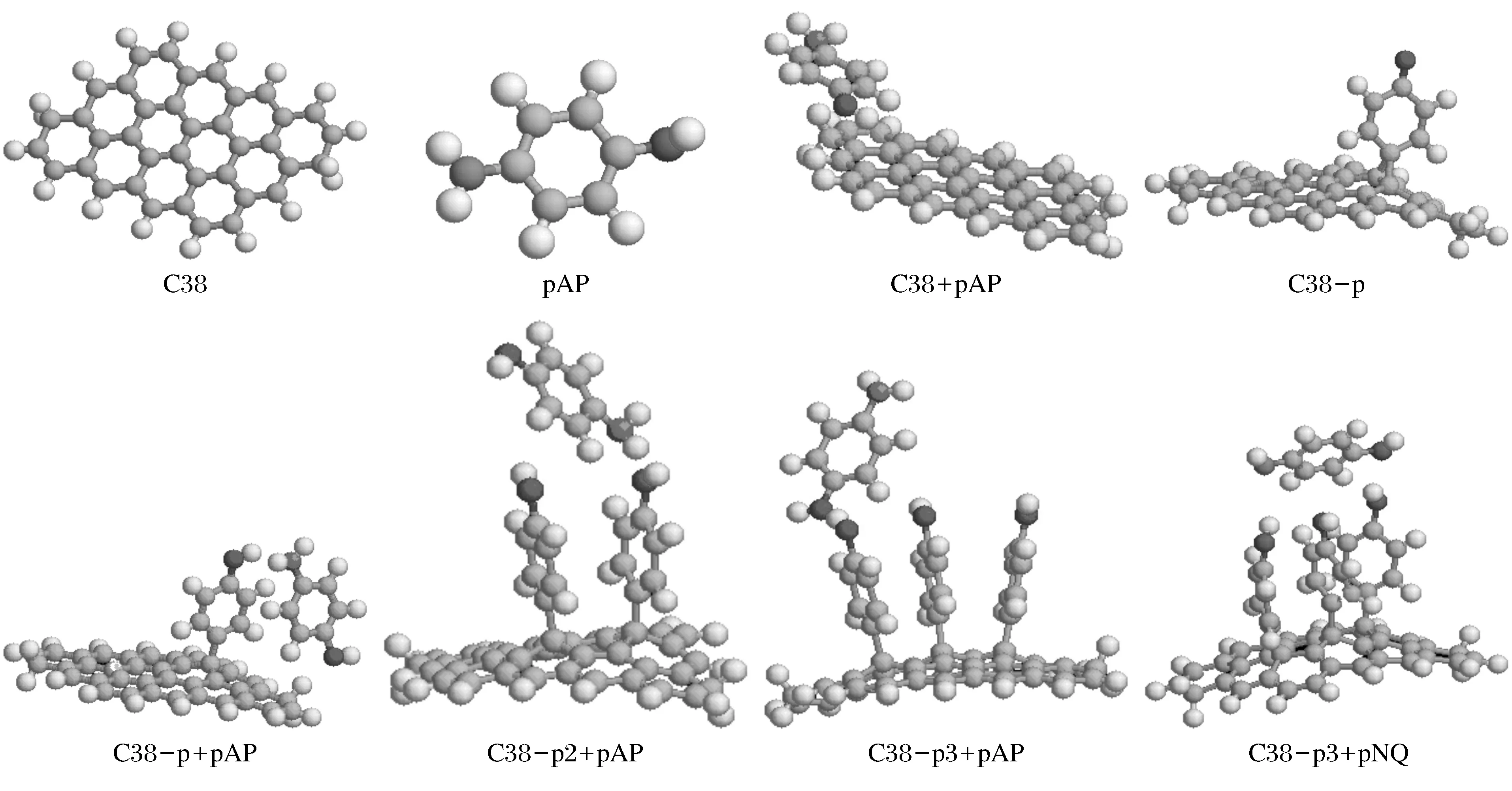
Fig.1 Molecule or molecular clusters
3 Results and discussions
3.1 Electrocatalytic behavior of p-aminophenol at the modified carbon paste electrodes
The cyclic voltammogram of p-aminophenol on the modified carbon paste electrode shows one oxidation peak located at 0.575 V(58.81 μA), and two reduction peaks at 0.356 V(41.671 μA), and 0.141 V (28.24 μA), respectively as shown in Fig.2A curve 1, while at the unmodified carbon paste electrode, there are also one oxidation peak at 0.648 V(36.71 μA), and two reduction peaks at 0.352 V(13.88 μA), and 0.151 V(4.96 μA) as shown in Fig.2 A curve 2. The modified electrode in electrolyte solution without p-aminophenol has no any peak at all as shown in Fig.2A curve 3.

(a)—Cyclic voltammograms; (b)— oxidation peak current with square root of scan rate

Fig.2 p-amino phenol at different carbon paste electrodes
Compared the curve 1 and curve 2 in Fig.2(a), it is an obvious electrochemical catalytic oxidation of p-aminophenol at p-phenol modified carbon paste electrode with oxidation peak potential negatively shifted about 0.073 V and an increase in oxidation peak current for about 60%. The oxidation peak current was plotted against squared root of scan rate as shown in Fig.2(b), a linear line was obtained with a regression equation of,

Thisrealationshipindicatestheoxidationisadiffusioncontrolledprocess.Thatmeanstheelectrochemicaloxidationrateisfasterthanthediffusionrate.Inordertounderstandtheelectrocatalyticbehavior,quantumchemicalcomputationalmethodswasperformed,andsomesignificantresultsweregivenasthefollowings.
3.2 Quantum chemical calculation results and analysis
3.2.1 Thermodynamic stability of molecule and molecular clusters
Heat of formation of molecule or molecular clusters can be easily obtained from the PM6 calculation in MOPAC2012, and used to evaluate the stability of molecule or molecular clusters. According to thermodynamic principle[28], the Gibbs free energy change(ΔGr) of a reaction can be calculated with enthalpy change(ΔHr) and entropy change(ΔSr) of the reaction, and described as,
The enthalpy change and entropy change of a reaction can be calculated fromheat and entropy of formations of products and reactants as,
Where n and m are the numbers of products and reactants, respectively included in the reactions.
The heats of formation of all the molecules and molecular clusters used in this work were calculated by PM6 semi-empirical quantum chemical method. The reaction heat of each cluster formation was also calculated according to equation (2~4) and listed in Table 1. All reaction heats of cluster formations are exothermal ones with negative values. If the influence of reaction entropy is too small compared with the reaction heat to be omitted, then the reaction Gibbs free energy is a negative too, so the reactions must be a spontaneous process. The heats of formation of clusters of C38 graphene with p-phenol groups are much higher, but after it interacts with another p-aminophenol with hydrogen bonds, and forms a new molecular cluster, the heat of formation is decreased rapidly. The new molecular cluster formation stabilizes the system, and makes the reaction occur spontaneously. The other molecular clusters follow the similar way with the similar tendency.
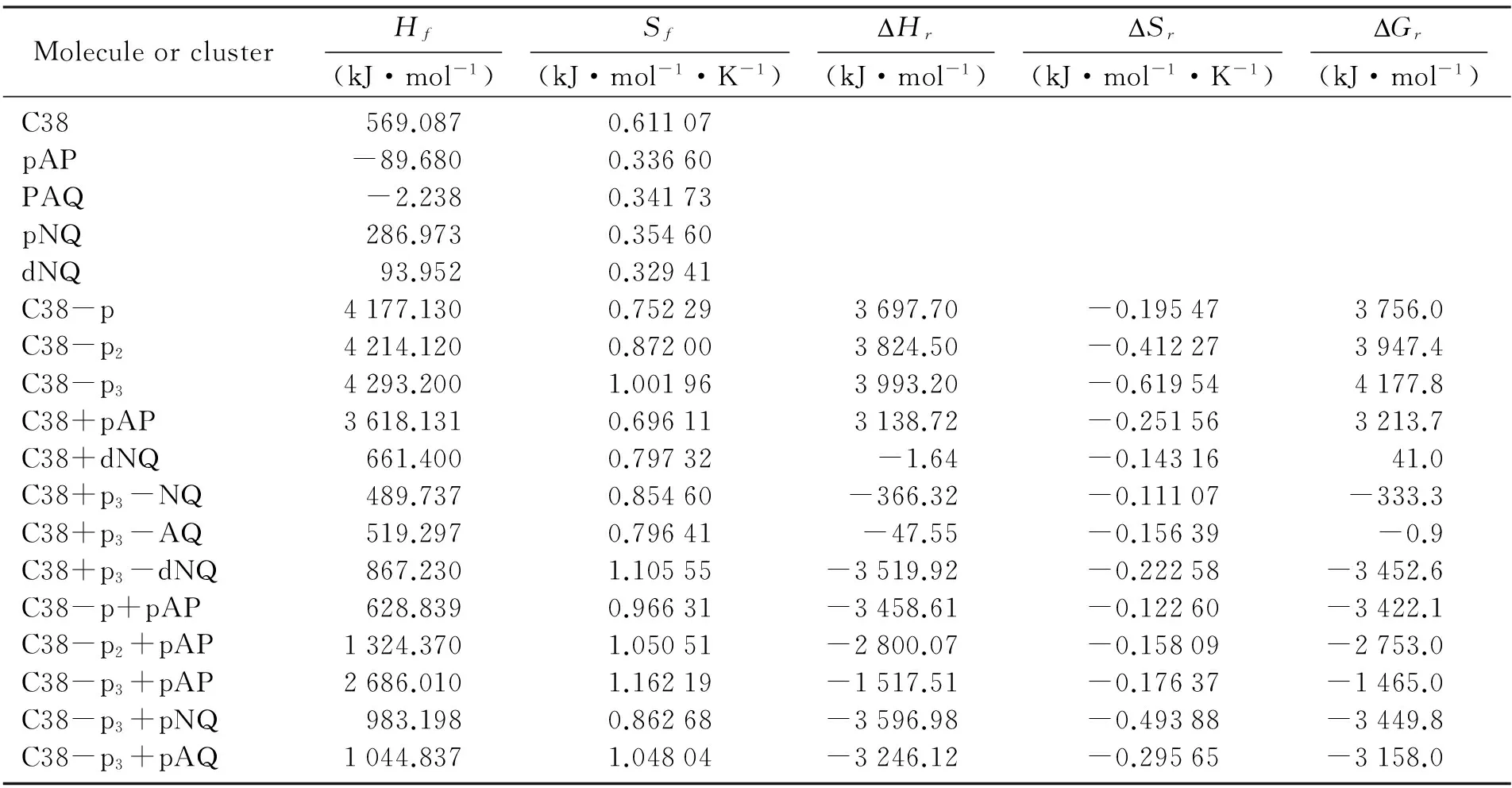
Tab.1 The calculated thermodynamic parameters of molecule or molecular cluster
All terms were the same as described in Fig.1.
3.2.3 Frontier orbital energy analysis
According to quantum chemical theory[29], there are n number of molecular orbitals linearly combined of m number of valence electron orbitals of the atoms in the molecule or molecular cluster as the following,

The Hamiltonian,Hi, of the system can be described as,
Wherehjis the kinetic energy part of the system;Vjis the potential energy part of the system. According to Schödinger equation,
Whereφiis the molecular orbital,Eiis the energy of the molecular orbital.so by performing quantum chemical calculation, we can obtained the energy of system, energy and function of each molecular orbital. According to the Kohn-Sham Theory, the frontier molecular orbital (FMO) composed of the highest occupied molecular orbital (HOMO) and the lowest unoccupied molecular orbital (LUMO) among the orbitals are very important in description of the chemical reactive tendency of a molecule with approximations may be useful for evaluation of electrochemical activity. Some descriptors were theoretical studied and reported such as the frontier orbital gap (ΔE), chemical potential (μ)[30], molecular hardness (η)[31], molecular electron affinity ()[32-33], and charge exchange (ΔN) fromAtoBmolecules[34-36]. All of these terms can be calculated from the frontier orbital energy of the HOMO (εHOMO) and LUMO (εLUMO). All these descriptors are defined as,
Here ΔNwas originally used to describe the electron transfer quantity from molecule A to molecule B, but in our case, it is used to describe the electron transfer from molecule A to another electrode or output electric circuit withμB, andηB=0, we called molecule B as environment, the new quantity may be called exchangeable electron. All energies of the frontier orbital and all the corresponding descriptors of the molecules and molecular clusters used in this work were calculated by PM6 in MOPAC2012 software, and listed in Table 2. In order to compare the electron transfer capacity of graphene C38 and modified C38 and other molecular clusters, we used the difference of the exchangeable electrons between any molecular cluster (ΔNMC) and graphene C38 (ΔNC38) to describes relative amount of exchangeable electrons included in the molecules or molecular clusters, we call it as difference of exchangeable electron (ΔΔN, as another descriptor) and may be defined as,
All terms were the same as decribed in Fig.1. The terms with”+” indicates the molecular cluster was calculated with a positive charge.
The difference of the exchangeable electrons values (ΔN) can be positive or negative. The positive value means the exchangeable electron of a molecular cluster is more than that of graphene, and may be likely to transfer the electron from the molecular cluster to graphene, and the molecular cluster may likely to be oxidized. In the negative case, the molecular cluster has less exchangeable electron than that of graphene, electron may be transferred from environment to the molecular cluster, and the molecular cluster through the graphene is likely to be reduced. So the difference of exchangeable electron may be used to evaluate the electron transfer possibility of a molecular cluster in the CPE system combined with the experimental results. From the calculation results in the Table 2, we can seen that all values from pAP to C38-p3+pAP are negative, that means the modifications and interaction of graphene C38 with the tested molecule have a tendency to reduce the exchangeable electron of the molecular cluster, and result in the reduction processes of the molecular clusters. This conclusion is not the case of the experiments result, where the oxidation process does really occur. In order to found the reasons of the unacceptable theoretical results, we further analyze the components of the frontier orbital of each molecule and molecular cluster in the next section.
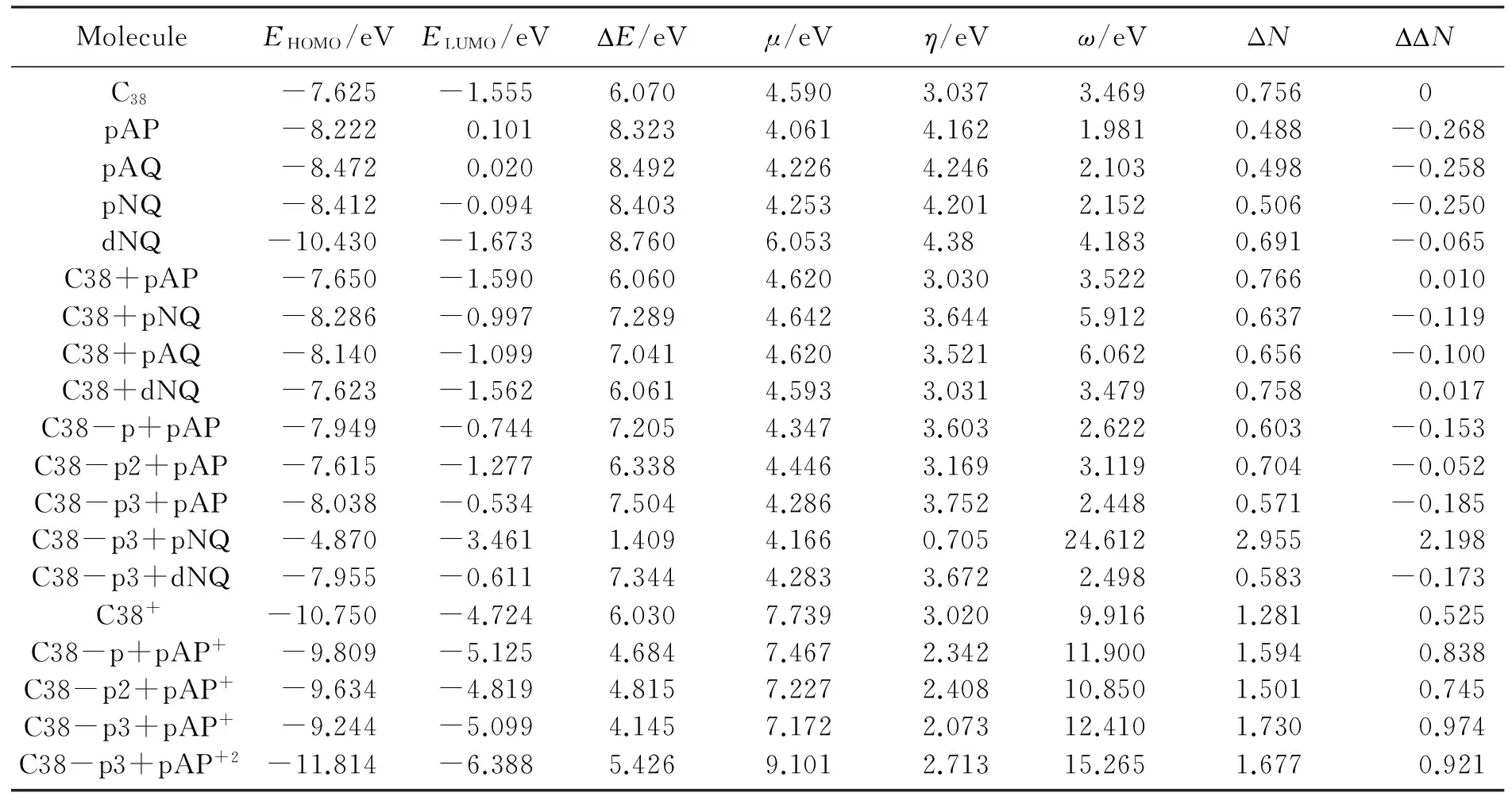
Tab.2 The calculated descriptors of molecule and molecular clusters
3.2.4 Component analysis of frontier orbital
The analysis of a molecular orbital components can help us to understand deeply the molecular activities in a chemical reactions, as well as electron transfer property. In our case, we can localize which group of the molecule taking part in the electron transfer process and which molecular orbital in the molecular cluster is mainly responsible for electrochemical oxidation reaction. All the frontier orbital including the LOMO and HOMO as well as the next HOMO were analyzed until we found out the group of our interested one, and all results were plotted in Fig.3.
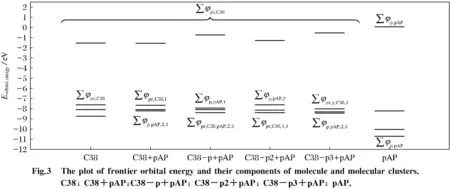
All of the LUMO and the first HOMOs of the molecule and molecular clusters are composed of carbon pz atomic orbital from C38 graphene except C38+pAP cluster, which is the composed of p orbitals of atoms of N, O an C in pAp molecule. The all carbon atoms in the graphene, C38, are sp2hybridized, and left pz atomic orbital with one p electron for the composite ofπmolecular orbital. These results indicate the frontier orbitals of graphene related clusters areπorπ*molecular orbitals with higher energies. The modifier of p-phenol group or interacting molecule of p-aminophenol only have small influences on the frontier orbital but not change the orbital components and the properties. The p-phenol group and p-phenol molecular orbials only insert into the groups of the C38 molecular orbitals with energy less than the frontier orbitals of C38. The next HOMO molecular orbitals of clusters including p-aminophenol molecular orbitals have smaller energy gap from the first HOMOs, so if the molecular cluster loss one electron and left one position for the electron transfer of p-aminophenol, then the situation will be changed. This is the electron transfer induced electrochemical catalysis. The out electric circuit draw one electron of graphene from the HOMO orbital composed of pz atomic orbital of carbon in graphene, and then electron in the next HOMO molecular orbital mainly composed of atomic orbitals of p-aminophenol becomes the first HOMO of the molecular cluster, and the next time to draw out one electron from the molecular cluster must be from the molecular orbital mainly composed of atomic orbitals in p-aminophenol. So we further perform the calculations of the systems with one positive charge. The all calculation results are listed in the last part of Table 2. In these cases, all the ΔEterms are much smaller than the corresponding systems with zero charge, which means the electron transfer from HOMO to LUMO is much easier than the corresponding zero charged molecular cluster. All ΔNterms of molecular clusters related to the oxidation of p-aminophenol are positive.
The plot of energies and components of frontier orbital for the one positively charged molecular clusters was shown in Fig.4. All of the LUMO orbital of the clusters are composed of carbon pz atomic orbital except that of C38+pAP, of which the first and second LUMOs are composed of the p orbitals of C, O and N atoms in pAP molecule, and the HOMO is composed of pz atomic orbital of C atom in C38 due to the first HOMO at zero charge state of the molecular cluster. All of other HOMO of the rest molecular clusters are composed of p orbital of O, N, and C in pAP molecule, so the nest step of electron transfer just from the molecule of pAP molecule, which results in the oxidation of this molecule, and responsible for the oxidation process.
From the comparison of the ΔNvalues of C38-p3+pAP with that of C38+pAP, It is very interested to found the value of ΔNis increased for about 64.8%, which is accord well with the oxidation peak current in CV curves in Fig.2 with 60.2% increased in oxidation peak current of p-amino-phenol at the p-phenol modified carbon paste electrode compared with that at the unmodified carbon paste electrode.
3.2.5 Relationship between redox potential and energies of frontier orbitals
The frontier orbitals of HOMO and LUMO are important in chemical reactions, especially in electrochemical reactions of receiving or losing electron from them.So as early as 1949, Maccoll showed the good relation between reduction potential of a conjugated system and the frontier orbital energy[37]. The oxidation potential,EOX, is proportional to the energy of HOMO,εHOMO, and the reduction potentialEREDis proportional to the energy of LUMO,εLUMO, and all together the expression can be written as[38],
WhereEOX/REDis the experimental potentials of oxidation and reductions, anda,bare constants. In our system, there are two molecular clusters involuing in the electrochemical redox reactions, one is the C38+pAP for the unmodified CPE and the other is the C38-p3+pAP for the modified CPE. In the C38+pAP molecular cluster shows one pair of well defined redox peaks related to the first electron transfer process, so the frontier orbitals of C38+pAP+were used. In the C38-p3-pAP cluster shows one pair of redox peaks for the first electron transfer process. The other reduction peak belongs to the second electron transfer process. So the quantum chemical calculation was perform again on the molecular cluster of C38-p3+pAP with two positive charge, so the calculation result were also liested in table 2 in term of C38-p3+pAP2+. The energy of LUMO (εLUMO=-6.388 eV) is responsible for the first reduction peak in CV curve. The plot of redox peak potentials against the energies of frontier orbitals is a linear (as shown in Fig.5) with a regression equation of,
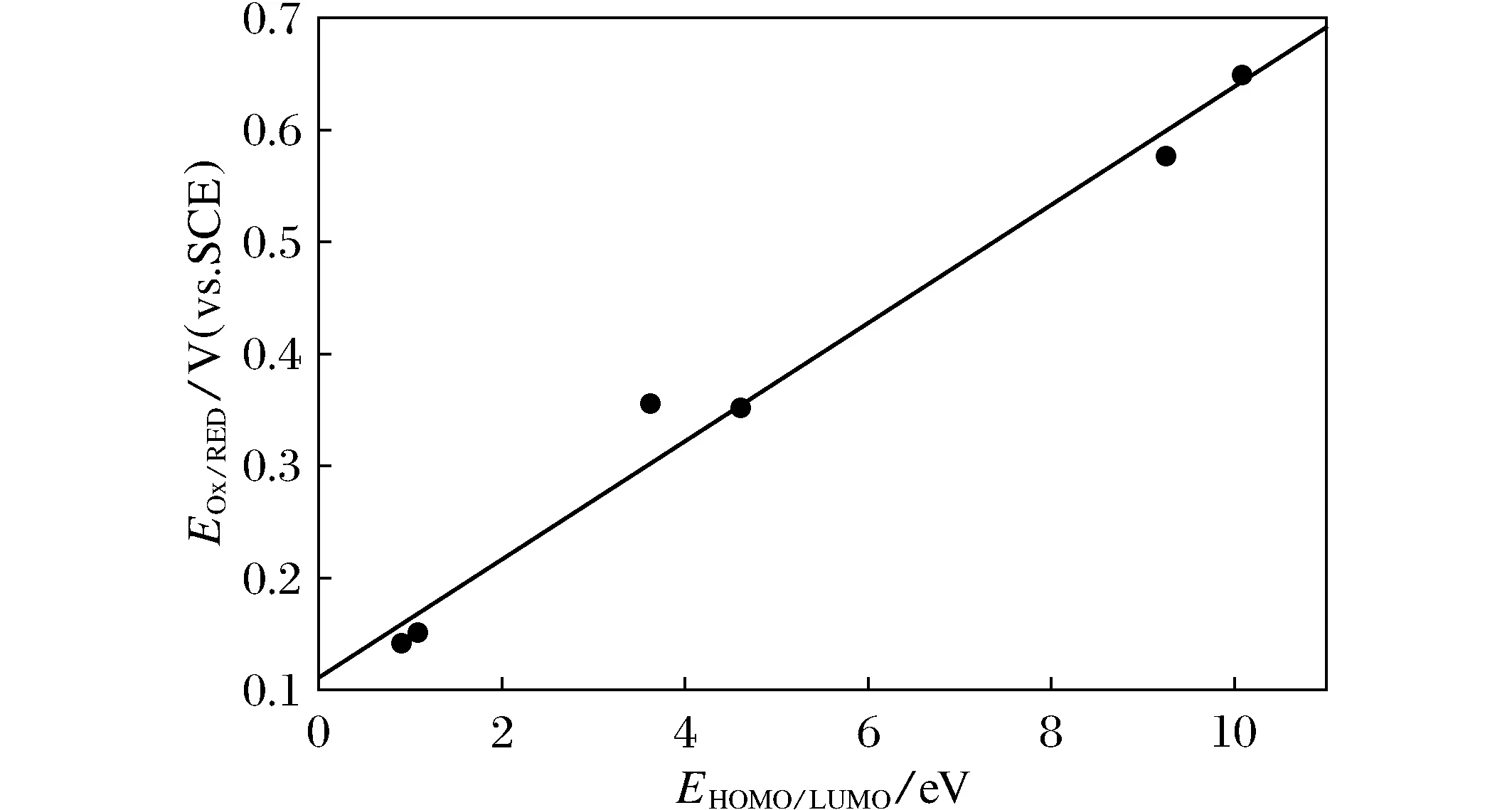
Fig.5 The relationship between redox potential and energy of frontier orbital of p-aminophenol
The good linear relationship of experimental peak potential and calculated frontier orbital energies further indicates that the quantum chemical calculations are accord well with the experimental results, and offers theoretical evidence for the electrocatalytic behavior of p-aminophenol at the p-aminophenol modified CPE. The second oxidation peak potential can be predicted from the energy of HOMO orbital in C38-p3+pAP2+(-11.814 eV) according to equation (11) as 0.824 V.
3.2.6 Qualitative explanation of the redox mechanism of p-aminophenol
In cyclic voltammogram in Fig.2, event the potential window was already up to 1.0 V, there is no second oxidation peak appear, however we obtained the second reduction peak with a relatively larger reduction peak current compared with the second one. The reason for this behavior may be that the first oxidation peak already includes the second oxidation step.
From organic chemistry view we known, the oxidation product of p-aminophenol is p-amino semiquinone (pAQ), which may tautomerize into p-hydroxylquinoneimine (pNQ), and corresponds to the second reduction peak. From the thermodynamic calculation results in Tab. 1 we can see that the reaction free energy of pNQ is -33.26 kJ/mol, -3 449.8 kJ/mol with C38 and C38+p3, respectively, while the reaction free energy for pAQ is -0.947 8 kJ/mol and -3 158 kJ/mol, respectively. That means pNQ in the molecular clusters are more stable than pAQ. In the tautomerization process, pNQ is preferable to pAQ. In molecular orbital calculation results in Table 2, the energy of first LUMO of pAQ in the molecular clusters is so the -1.099 eV and -3.679 eV with C38 and C38+p3, respectively, while the ones of pNQ is -0.997 eV and -3.461 eV, respectively. That means in the two cases the pAQ is easier to be reduced than pNQ. So the first reduction peak belongs to pAQ, and second reduction peak belongs to pNQ. Because in the two cases the pNQ is more stable than pAQ, so after pAQ produced, it tautomerizes to pNQ mainly, that is responsible for the larger reduction peak current of second one than the first one. The electrochemical redox mechanism may be described as,

In this way, we can explain qualitatively the all the redox peaks in the experimental CVs from thermodynamic points.
4 Conclusions
In the present paper, graphite powder surface was chemically modified with p-amino-phenol by diazo reaction, and shows electrochemical catalytic behavior for p-amino-phenol. Semi-empirical quantum chemical method of PM6 in MOPAC2012 software was used in quantum chemical calculations based on the molecular cluster models including graphene with 38 carbons, p-phenol groups and p-aminophenol. Some conclusions were summarized as the followings. The designed molecular cluster models are stable from the thermodynamic view. The catalytic behavior comes from electron transfer induced catalytic electrochemical oxidation by analysis of frontier orbital energy and composited components. The difference of exchangeable electron can be used to describe the electron transfer possibility which is accord well with the increase of oxidation peak current. The quantum chemical calculations combined with the molecular descriptors will help us to deeply understand the electrochemical catalytic behavior of the systems. The combination of redox potentials shows a linear relation with the calculated energies of frontier orbital, which can be used to predict the unknown redox potential of a molecule, and help us to understand the electrochemical mechanism of the molecule.
Acknowledgements
The authors would like to acknowledge the financial supports of the Chinese National Science Foundation (2004DFA02700), Liaoning Education Minister(2004-c022)and national key, and National Key Laboratory on Electroanalytical Chemistry (2006-06).
[ 1 ]CORDERO-RANDO M M, HIDALGO-HIDALGO de C J L, BLANCO E,et al. The sonogel-carbon electrode as a Sol-Gel graphite-based electrode[J]. Anal Chem, 2002,74(10):2423-2427.
[ 2 ]BELLIDO-MILLA D, CUBILLANA-AGUILERA L M, KAOUTIT M E, et al. Recent advances in graphite powder-based electrodes[J]. Anal Bioanal Chem, 2013,405(11):3525-3539.
[ 3 ]HAO J, ZHU Yongchun, LI G. Electrochemical liquid membrane micro-extraction of bromide on ethyl benzoate coated graphite-epoxy composite electrode surface by cyclic voltammetry[J]. Microchim Acta,2009, 167(3):267-272.
[ 4 ]VYTRAS K, ?倲VANCARA I, METELKA R. Carbon paste electrodes in electroanalytical chemistry[J]. J Serb Chem Soc, 2009,74(10):1021-1033.
[ 5 ]SISWANA M, OZOEMENA K I, NYOKONG T. Electrocatalytic behaviour of carbon paste electrode modified with iron (Ⅱ) phthalocyanine (FePc) nanoparticles towards the detection of amitrole[J].Talanta, 2006, 69(5):1136-1142.
[ 6 ]ZHAI Z Q, WU J, SUN W, et al. Direct electrochemistry of hemoglobin and its electrocatalysis based on a carbon nanotube paste electrode[J]. J Chinese Chem Soc, 2009(2):56:561-567.
[ 7 ]PUNBUSAYAKULYAKUL N. carbon nanotubes architectures in electroanalysis[J]. Procedia Engin, 2012,32(1):683-689.
[ 8 ]LI M, WU Z. A review of intercalation composite phase change material: Preparation, structure and properties[J]. Renew Sustain Energ Rev, 2012,6(4):2094-2101.
[ 9 ]APETREI C, APETREI I M, DE SAJA J A, et al. Carbon paste electrodes made from different carbonaceous materials: application in the study of antioxidants[J]. Sens, 2011,11(2):1328-1344.
[10]RAHBAR N, PARHAM H. Carbon baste electrode modified with Cuo-nanoparticles as a probe for square wave voltammetric determination of atrazine[J]. Jundishapur J Nat Pharm Prod, 2013,8(3):118-124.
[11]AGLANL R F, MOHAMED G G, MOHAMED H A. Chemically modified carbon paste electrode for determination of cesium ion by potentiometric method[J]. Am J Anal Chem, 2012,3(8):576-586.
[12]SIM C M, HONG Y J, KIM M H, et al. Voltammetry behavior of modified carbon paste electrode with cytochrome C and Mn2O3nanoparticles for hydrogen peroxide sensing[J]. Int J Electrochem Sci, 2012,7(12):12098-12109.
[13]STRELKO V V, DUDARENKO V V, LAVRIENKO-OMETSINSKAYA E D. Quantum-chemical interpretation of some electrochemical properties of activated carbons[J]. Ukr Khim Zh, 1987,53(6):820-824.
[14]LAVRINENKO-OMETSINSKAYA E D, REPYAKH I V, KARTEL N T, et al. States of a heteroatom in graphite-like structures of nitrogen-containing carbons[J].Teor kspo Khim, 1982,18(2):224-227.
[15]JAMAL M, SARAC A S, MAGNER E. Conductive copolymer-modified carbon fibre microelectrodes: electrode characterisation and electrochemical detection of p-aminophenol[J]. Sens Actuat B, 2004,97(1):59-66.
[16]SUN W, JIAO K, ZHANG S, et al. Electrochemical detection for horseradish peroxidase-based enzyme immunoassay using p-aminophenol as substrate and its application in detection of plant virus[J]. Anal Chim Acta, 2001,434(1):43-50.
[17]HALSALL H B, HEINEMAN W R, JENKINS S H. Capillary immunoassay with electrochemical detection[J]. Clin Chem, 1988,34(9):1701-1702.
[18]WIJAYAWARDHANA C A, HALSALL H B, HEINEMAN W R. Micro volume rotating disk electrode (RDE) amperometric detection for a bead-based immunoassay[J]. Anal Chim Acta, 1999,399(1):3-11.
[19]GIL EP, Tang H, Halsall B,et al. Competitive heterogeneous enzyme immunoassay for theophylline by flow-injection analysis with electrochemical detection of p-aminophenol[J]. Clin Chem, 1990,36(4):662-665.
[20]ENSAFI A A, HEYDARI-BAFROOEI E, REZAEI B. Simultaneous detection of hydroxylamine and phenol using p-aminophenol-modified carbonnanotubepaste electrode[J]. Chin J Catal, 2013,34(9):1768-1775.
[21]AHMED T M F, SANKARAPAPAVINASAM S. Poly(para-aminophenol): a new soluble, electroactive conducting polymer[J]. J Electroanal Chem, 1992, 338(1/2):347-352.
[22]KWON S J, YANG H, KWARK K J J. An electrochemical immunosensor using p-aminophenol redox cycling by NADH on a self-assembled monolayer and ferrocene-modified Au electrodes[J]. Analyst , 2008,133(11):1599-1604.
[23]AGUILAR Z P, FRITSCH I. Immobilized enzyme-linked DNA-hybridization assay with electrochemical detection for cryptosporidium parvum hsp70 mRNA[J].Anal Chem, 2003,75:3890-3897.
[24]SREWART J J P. Application of the PM6 method to modeling the solid state [J]. J Mol Model, 2008,14(6):499-535.
[25]CLARK T. A handbook of computational chemistry: a practical guide to chemical structure and energy calculations[M]. New York:Wiley, John & Sons, Incorporated, 1985.
[26]ZHU Yongchun, GUAN J, CAO L, et al. Electrochemical solid phase nano-extraction and determination of trace iodide in iodised table salt on silver sulfate-modified carbon paste electrode by differential pulse voltammetry[J]. Talanta, 2010,80(3):1234-1238.
[27]STEWART J J P. Optimization of parameters for semiempirical methods V:modification of NDDO approximations and applications to 70 elements[J]. J Mol Model, 2007,13(12):1173-1213.
[28]CALLEN H B. Thermodynamics and introduction to thermostatistics[M]. New York:Wiley, 1985.
[29]MAGNASCO V. Methods of molecular quantum mechanics: an introduction to electronic molecular structure[M]. United Kingdom:John Wiley and sons, Ltd, Chichester, 2009.
[30]CHOI Y, MEBANE DS, WANG J, et al. Continuum and quantum-chemical modeling of oxygen reduction on the cathode in a solid oxide fuel cell[J]. Top Catal, 2007,46(3):386-401.
[31]CALLEN H B. Thermodynamics and introduction to thermostatistics[M]. New York: Wiley, 1985.
[32]PARR RG, DONNELLY RA, LEVY M, et al. Electronegativity: the density functional viewpoint[J]. J Chem Phys, 1978,68(8):3801-3807.
[33]PEARSON R G. Hard and soft acids and bases[J]. J Am Chem Soc, 1963,85(26):3533-3539.
[34]PARR R G, SZENTPALY LV, LIU S. Electrophilicity index[J]. J Am Chem Soc, 1999,121(9):1922-1924.
[35]MENDEZ F, GARCIA-GARIBAY MA. A hard soft acid base and DFT analysis of singlet triplet gaps and the addition of singlet carbenes to alkenes[J]. J Org Chem, 1999,64(19):7061-7066.
[36]SURENDRA B N. Computational studies foroxidation reduction reactions of cinnoline-4(1H)-one, in aqueous phase by density functional theory[J]. Brit J Appl Sci Techn, 2014,4(3):465-467.
[37]MACCOLL A. Reduction potentials of conjugated systems[J]. Nature, 1949,163:178-179.
1673-5862(2016)03-0343-11
对氨基酚在修饰碳糊电极上电氧化的PM6法研究
朱永春1,2, 蒋清笑2, 苏桂田2, 陈庆阳2
(1. 沈阳师范大学 能源与环境催化研究所, 沈阳 110034;2. 沈阳师范大学 化学化工学院, 沈阳 110034)
以重氮化反应将对氨基化学修饰在石墨粉表面上并构建成碳糊电极。在此修饰电极上对-氨基酚表现处电化学催化氧化行为,与裸电极相比,氧化峰电位负移了73 mV,氧化峰电流升高了60%。为了从分子水平上深入了解这种催化氧化行为,以38个碳构成的石墨烯片段-对氨基-对氨基酚组成的分子簇模型,MOPAC2012软件包内的PM6半经验分子轨道法研究了真空条件下体系的电化学催化活性。计算结果表明,所有建立的分子簇模型都是热力学稳定的,都具有负的反应吉布斯自由能。前线分子轨道的分析给出了电化学催化诱导下的电子转移过程,并定性地解释了对氨基酚在修饰和未修饰电极上的电化学氧化机理。对氨基酚在修饰电极上的可交换电子量比在未修饰电极上的大了64.8%。此结果恰好与试验结果中的氧化峰电流的升高结果一致;试验结果中的氧化还原峰电位对计算结果中的相应最高占有轨道和最低空轨道能呈现很好的线性关系。
半经验分子轨道理论; 对氨基酚; 化学修饰碳糊电极; 电化学催化; 石墨粉
date: 2015-05-17.
O646 Document code: A
10.3969/ j.issn.1673-5862.2016.03.019
Supported: Project supported by National Natural Science Foundation of China (20807563).
Biography: ZHU Yongchun(1955-), male, was born in Huaide city of Jilin province, professor of Shenyang Normal University, doctor.
